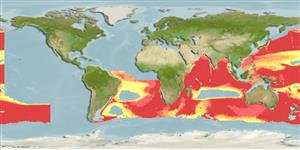Environment: milieu / climate zone / depth range / distribution range
Écologie
marin bathypélagique; profondeur ? - 2000 m (Ref. 4456). Deep-water
Southern region of all oceans except the Eastern Pacific.
Taille / Poids / Âge
Maturity: Lm ? range ? - ? cm
Max length : 77.0 cm TL mâle / non sexé; (Ref. 4456)
Description synthétique
Clés d'identification | Morphologie | Morphométrie
Dark brown to black in color (Ref. 3248). Dorsal rays 325-436, anal rays 280-368 (Ref. 3248).
Apparently entering the upper water column (Ref. 47377).
Life cycle and mating behavior
Maturité | Reproduction | Frai | Œufs | Fécondité | Larves
Smith, D.G., 1990. Nemichthyidae. p. 199-202. In J.C. Quero, J.C. Hureau, C. Karrer, A. Post and L. Saldanha (eds.) Check-list of the fishes of the eastern tropical Atlantic (CLOFETA). JNICT, Lisbon; SEI, Paris; and UNESCO, Paris. Vol. 1. (Ref. 4456)
Statut dans la liste rouge de l'IUCN (Ref. 130435: Version 2024-1)
Menace pour l'homme
Harmless
Utilisations par l'homme
Pêcheries: sans intérêt
Outils
Articles particuliers
Télécharger en XML
Sources Internet
Estimates based on models
Preferred temperature (Ref.
123201): 2.4 - 5.7, mean 3.6 °C (based on 753 cells).
Phylogenetic diversity index (Ref.
82804): PD
50 = 0.5645 [Uniqueness, from 0.5 = low to 2.0 = high].
Bayesian length-weight: a=0.00102 (0.00046 - 0.00225), b=3.06 (2.88 - 3.24), in cm total length, based on all LWR estimates for this body shape (Ref.
93245).
Niveau trophique (Ref.
69278): 3.4 ±0.4 se; based on size and trophs of closest relatives
Résilience (Ref.
120179): Faible, temps minimum de doublement de population : 4,5 à 14 années (Assuming tmax>10).
Fishing Vulnerability (Ref.
59153): Moderate to high vulnerability (51 of 100).
